1996 PONTIAC GRAND-AM tires
[x] Cancel search: tiresPage 171 of 356
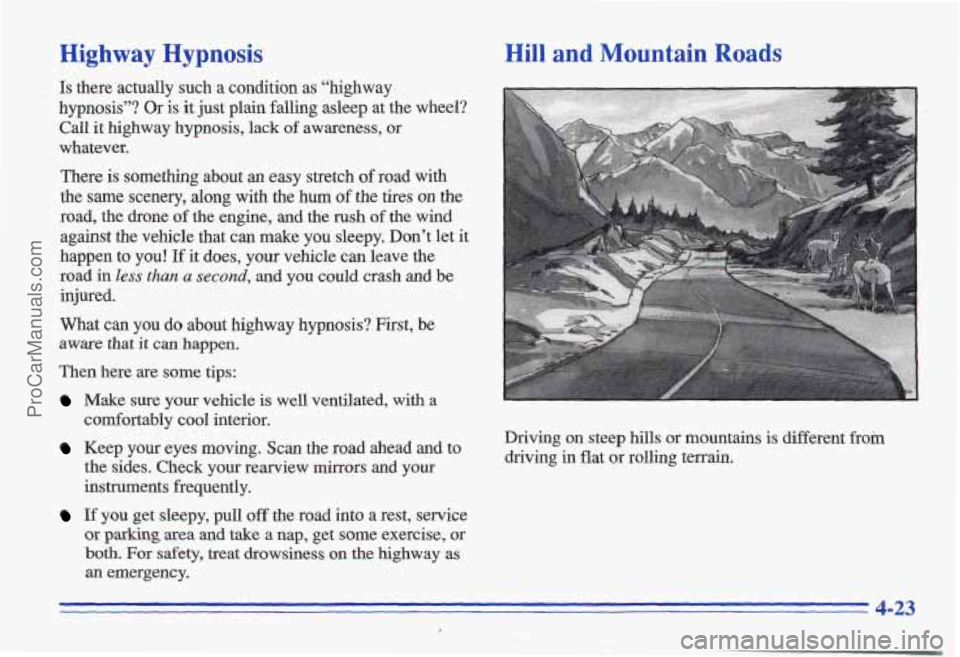
Highway Hypnosis
Is there actually such a condition as “highway
hypnosis”? Or is it just plain falling asleep at the wheel?
Call it highway,hypnosis, lack
of awareness, or
whatever.
There is something about an easy stretch of road with
the
same scenery, along with the hum of the tires on the
road, the drone
of the engine, and the rush of the wind
against the vehicle that can make you sleepy. Don’t let it
happen to you!
If it does, your vehicle can leave the
road
in Zess than a second, and you could crash and be
injured.
What
can you do about highway hypnosis? First, be
aware that it can happen.
Then here are some tips:
Make sure your vehicle is well ventilated, with a
Comfortably cool interior.
Keep your eyes moving. Scan the road ahead and to
the sides. Check your rearview mirrors and your
instruments frequently.
If you get sleepy, pull off the road into a rest, service
or
parking area and take a nap, get some exercise, or
both. For safety, treat drowsiness on the highway as
an emergency.
Hill and Mountain Roads
Driving on steep hills or mountains is different from
driving
in flat or rolling terrain.
4-23
ProCarManuals.com
Page 172 of 356
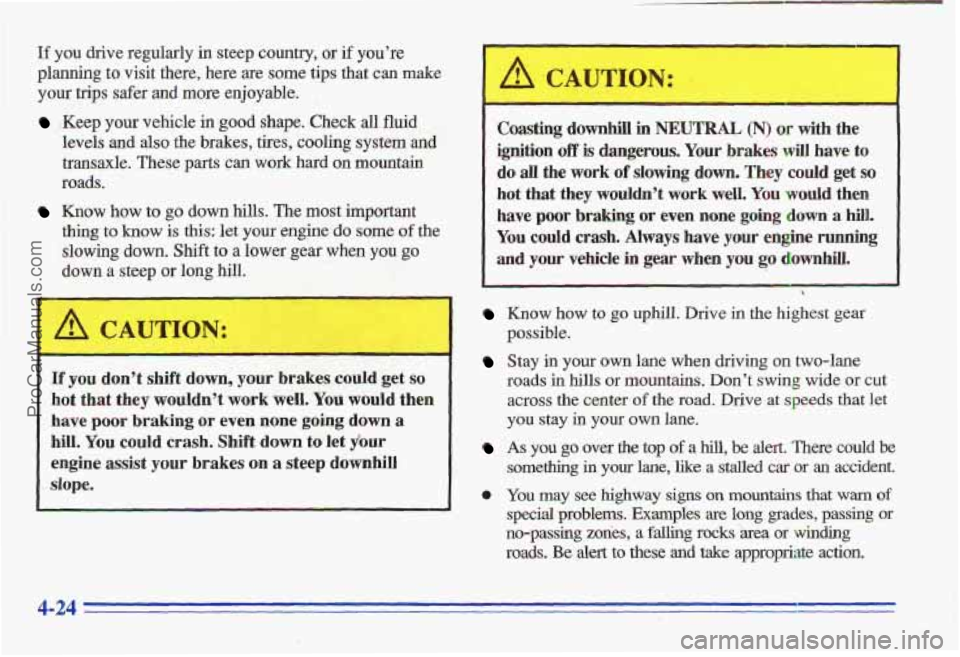
If you drive regularly in steep country, or if you’re
planning t’o visit there, here are some tips that can make
your trips safer and more enjoyable.
!Keep your vehicle in good shape. Check dl fluid
levels
and also the brakes, tires, cooling system and
transaxle.
These parts can work hard on mountain
roads.
Know Bow to go down hills. The most important
thing to know is this: let your engine do some of the
slowing down. Shift to a lower gear when you go
down a steep or long hill.
If you don’t shift down, your brakes could get so
hot that they wouldn’t work well. You would then
have poor braking
or even none going ddwn a
hill. You could crash. Shift down to let jour
engine assist
your brakes on a steep. downhill
.. slope.
Coasting downhill in NEUTRAL (N) or dvith the
ignition
off is dangerous. Your brakes will have to
do all the work of slowing down. They could get so
hot that they wouldn’t work well. You would then
haxe
poor braking or even none going down a hill.
You could crash. Always have your engine running
and your vehicle
in gear when you go downhill.
Know how to go uphill. Drive in the highest gear
possible.
Stay in your own lane when driving on two-lane
roads
in hills or mountains. Don’t swing wide or cut
across the center
of the road. Drive at speeds that let
you stay in your own lane.
As you go over the top of a hill, be alert. There could be
something in your lane, like a stalled car or an accident.
0 You may see highway signs on mountains that warn of
special problems. Examples are long grades, passing or
no-passing
zones, a falling rocks Area or winding
roads. Be alert to these and take appropriate action.
ProCarManuals.com
Page 174 of 356
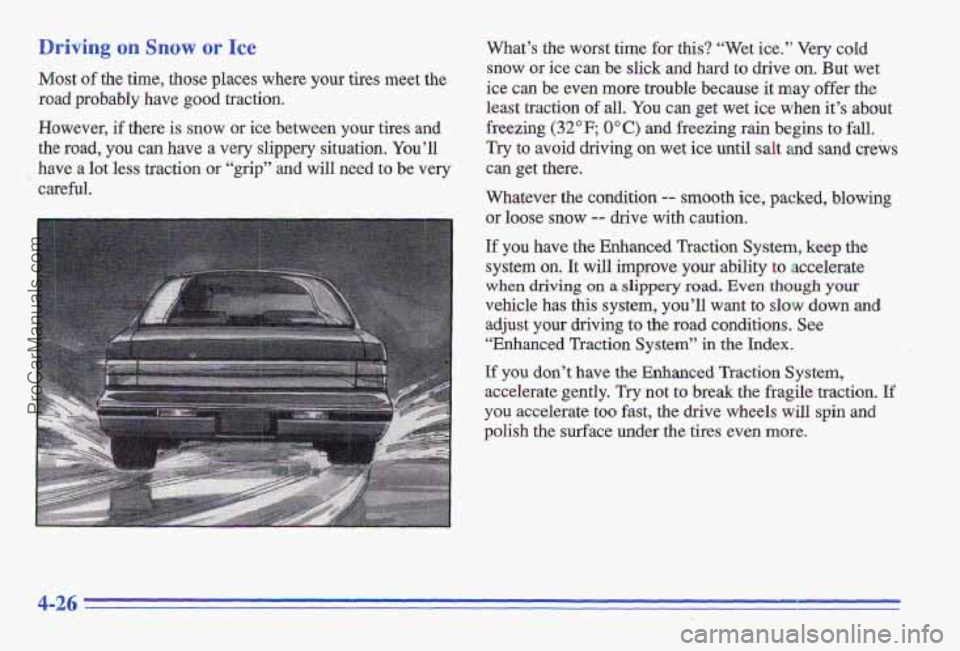
Driving on Snow or Ice
Most of the time, those places where your tires meet the
road probably have good traction.
However,
if there is snow or ice between your tires and
the road, you can have a very slippery situation. You’ll
have a lot less traction or “grip” and will need to be very
careful.
What’s the worst time for this? “Wet ice.” Very cold
snow or ice can be slick and hard to drive on. But wet
ice
can be even more trouble because it may offer the
least traction of all. You can get wet ice when it’s about
freezing
(32°F; PC) and freezing rain begins to fall.
Try to avoid driving on wet ice until salt and sand crews
can get there.
Whatever the condition
-- smooth ice9 packed, blowing
or loose snow -- drive with caution.
If you have the Enhanced Traction System, keep the
system
on. It will improve your ability to accelerate
when driving on a slippery road. Even though your
vehicle has this system, you’ll want to slow down and
adjust your driving tu the road conditions. See
“Enhanced
Traction System” in the Index.
If you don’t have the Enhanced Traction System,
accelerate gently.
Try not to break the fragile traction, If
you accelerate too fast, the drive wheels will spin and
polish the surface under th,e tires even more.
4-26 ,
ProCarManuals.com
Page 180 of 356
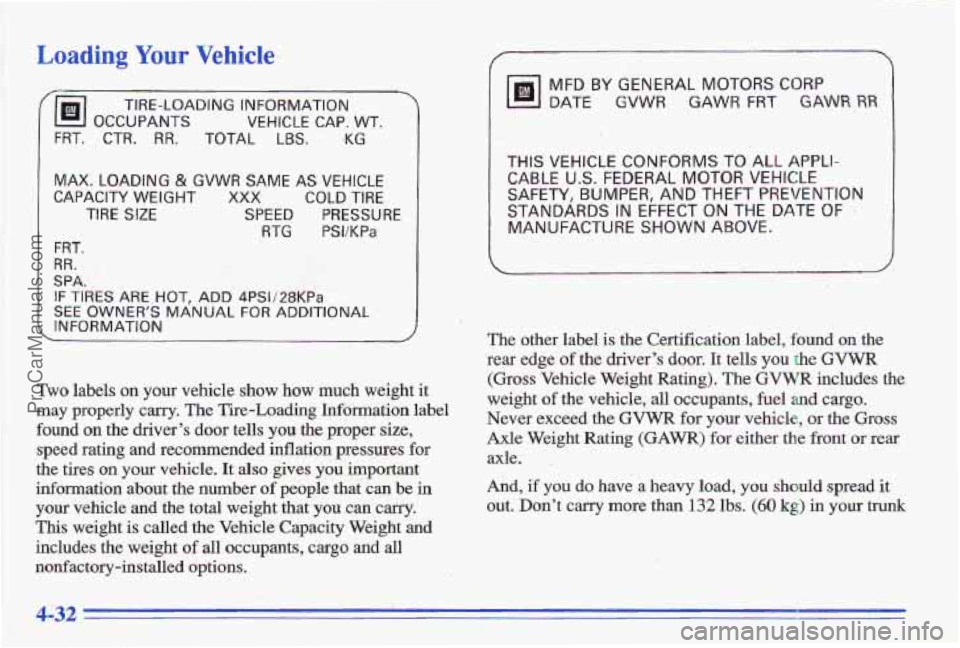
Loading Your Vehicle
/@!!!I OCCUPANTS VEHICLE CAP. WT.
TIRE-LOADING INFORMATION
FRT. CTR. RR. TOTAL LBS. *KG
. ..
MAX. LOADING & GVWR SAME AS VEHICLE
CAPACITY WEIGHT XXX COLD TIRE
TIRE SIZE SPEED PRESSURE
FRT.
RTG PSI/KPa
RR.
SPA.
IF TIRES ARE,HOT, ADD 4PS1/28KPa
SEE OWNER'S MANUAL FOR ADDITIONAL
INFORMATION
Two labels on your vehicle show how much weight it
may properly carry. The Tire-Loading Information label
found on the driver's door tells
you the proper size,
speed rating and recommended inflation pressures for
the tires on
your vehicle. It also gives you important
information about
the number of people that can be in
your vehicle and the total weight that you can carry.
This weight is called the Vehicle Capacity Weight and
includes the weight of all occupants, cargo and all
nonfactory-installed
options.
THIS VEHICLE CONFORMS TO ALL APPLI-
SAFETY, BUMPER, AND THEFT PREVENTION
MANUFACTURE SHOWN ABOVE.
CABLE- U.S. FEDERAL MOTOR VEHICLE
STANDARDS IN EFFElCT ON THE DATE OF
The other label is the Certification label, found on the
rear edge of the driver's door. It tells you the GVMrR
(Gross Vehicle Weight Rating). The GVWa includes the
weight of the vehicle, all occupants, fuel and cargo.
Never exceed the
GVWa for your vehicle, or the Gruss
Axle Weight Rating (GAWR) for either the front or rear
axle.
.
And, if you do have a heavy load, you should spread it
out. Don't carry
more than 132 lbs. (60 kg) in your trunk
4-32
ProCarManuals.com
Page 182 of 356
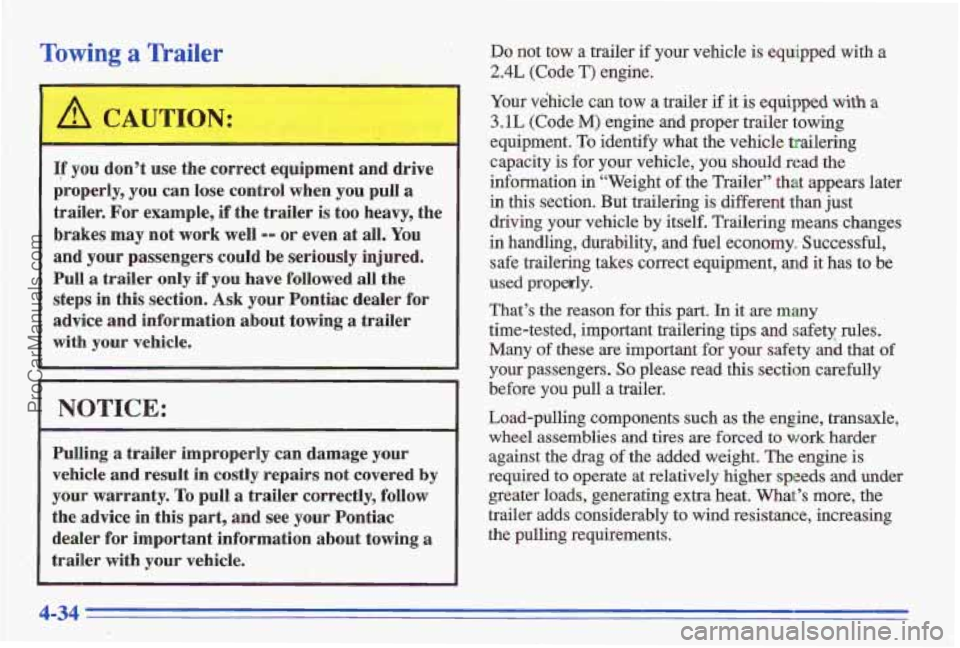
Towing a Trailer
A CAUTION:
If you don't use the correct equipment and drive
properly, you can lose control when
you pull a
trailer. For example, if the trailer is too heavy, the
brakes may not
work well -- or even at all.. You
and your passengers could be seriously injured.
Pull
a trailer only if you have followed all the
steps in this section.
Ask your Pontiac dealer for
advice and information about towing
a trailer
with your vehicle.
Pulling
a traikr improperly can damage your
vehicle and result in costly repairs not covered
by
your warranty. To pull a trailer correctly, follow
the advice in this part, and
see yumr Pontiac
dealer for important information about towing
a
trailer with your vehicle.
Bo not tow a trailer if your vehicle is equipped with a
2.4L (Code T) engine.
Your vehicle can tow a trailer if it is equipped with a
3.1L (Code M) -engine and proper trailer towing
equipment,
To identify what the vehicle trailering
capacity
is for your vehicle, you should read the
information
in "Weight of the Trailer'' that appears later
in this section. But trailering is different than just
driving your vehicle
by itself. Trailering means changes
in handling, durability, md fuel economy. Successful,
safe trailering takes correct equipment, and it has to be
used propetly.
That's the reason for this
part. In it are many
time-tested, important trailering tips and safe% rules.
Many of these are important for your safety and that of
your passengers. So please read this section carefully
before you pull a trailer.
Load-pulling components such as the engine, transaxle,
wheel assemblies and tires are forced to work harder
against
the drag of the added weight. The engine is
required to operate at relatively
higher speeds and under
greater loads, generating extra heat. What,'s more, the
trailer adds considerably to wind resistance, increasing
the gulling requjsernents.
1'
4-34
ProCarManuals.com
Page 183 of 356
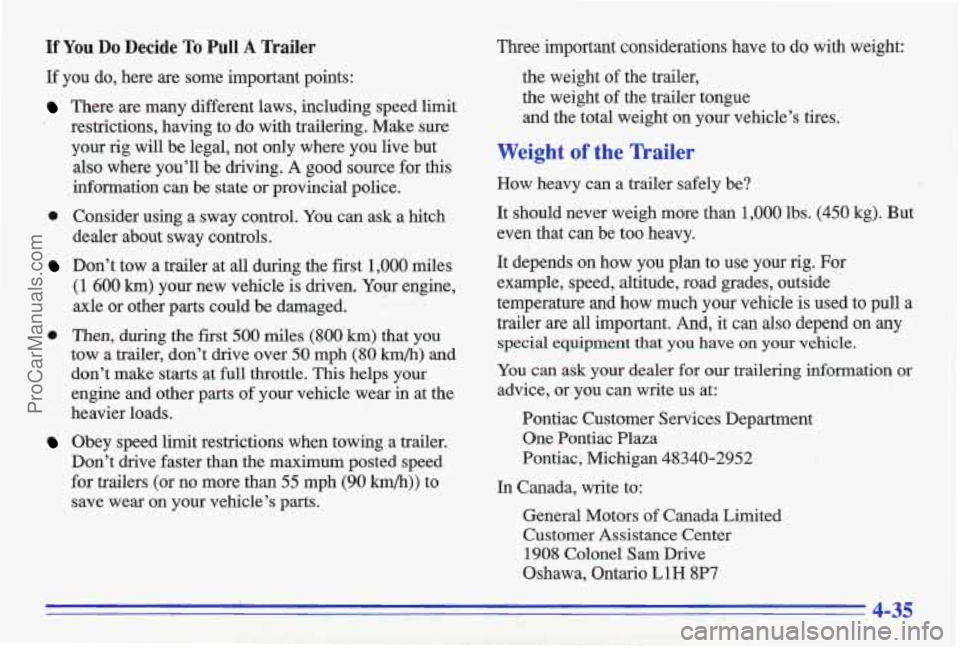
If You Do Decide To Pull A Trailer
If you do, here are some important points:
Three important considerations have to do with weight:
the weight
of the trailer,
There are many different laws, including speed limit
’ restrictions, having to do with trailering. Make sure
your
rig will be legal, not only where you live but Weight of the Trailer
also where you’ll be driving. A good source for this
inforrnation can be state or provincial police. How heavy can a trailer safely be? the weight
of the trailer tongue
and the total weight on your vehicle’s tires.
0 Consider using a sway control. You can ask a hitch It should never weigh more than 1,000 lbs. (450 kg). But
dealer about sway Controls’. even that can be
too heavy.
Don’t tow a trailer at all during the first 1,000 miles It depends on how YOU plan
to use Your fig. For
(1 600 km) your new vehicle is driven. Your engine, exmPle,
speed, altitude, road grades, outside
axle or other parts could
be damaged. temperature and how much your vehicle
is used to pull a
tow a trailer, don’t drive over 50 mph (80 h/h) and
don’t make starts at full throttle. This helps your
You can ask your dealer for our trailering information or
engine and other parts of your vehicle wear in at the advice, Or-You Can write
US at:
heavier loads. Pontiac Customer Services Department
Don’t drive faster than the maximum posted speed Pontiac, Mi\
chigan 48340-2952 trailer are
all important. And,
it can also depend on any 0 Then, during the first 500 miles (800 km) that you
special equipment that you have on your vehicle.
Obey speed limit restrictions when towing a trailer. One Pontia\
c Plaza
for trailers (or no more than 55 mph (90 lun/hj) to
save wear on your vehicle’s parts. In Canada, write to:
General Motors of Canada Limited
Customer Assistance Center
1908 Colonel Sam Drive
Oshawa, Ontario
L1H 8P7
4-35
ProCarManuals.com
Page 184 of 356
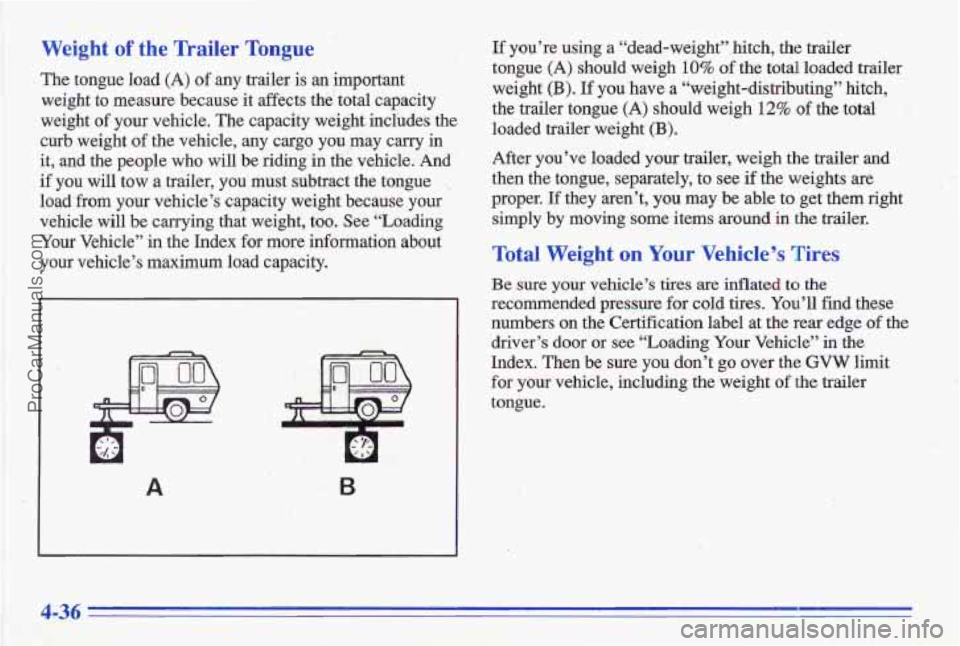
Weight of the Trailer Tongue
The tongue load (A) of any trailer is an important
weight to measure because it affects the total capacity
weight of your vehicle. The capacity weight includes the
curb weight of the vehicle, any cargo you may carry
in
it, and the people who will be riding in the vehicle. And
if you will tow a trailer, you must subtract the tongue _.
load from your vehicle’s capacity weight because your
vehicle will be carrying that weight,
too. See “Loading
Your Vehicle” in the Index for more information about
yow vehicle’s maximum load capacity.
B
If you’re using a “dead-weight” hitch, the trailer
tongue
(A) should weigh 10% of the total loaded trailer
weight
(€3). If you have a “weight-distributing” hitch,
the trailer tongue
(A) should weigh 12% of the total
loaded
trailer weight (B).
After you’ve loaded your trailer, weigh the trailer and
then the tongue, separately, to see if the weights me
proper. If they aren’t, you may be able to get them right
simply
by moving some items around in the trailer.
Total Weight on Your Vehicle’s Tires
Be sure your vehicle’s tires are inflated to the
recornended pressure for cold tires. You’ll find these
numbers on
the Certification label at the rear edge of the
driver’s door or see “Loading Your Vehicle” in the
Index. Then be sure you don’t
go over the GVW limit
for your vehicle, including the weight
of the trailer r
tongue.
.’ . :
4-36
ProCarManuals.com
Page 186 of 356
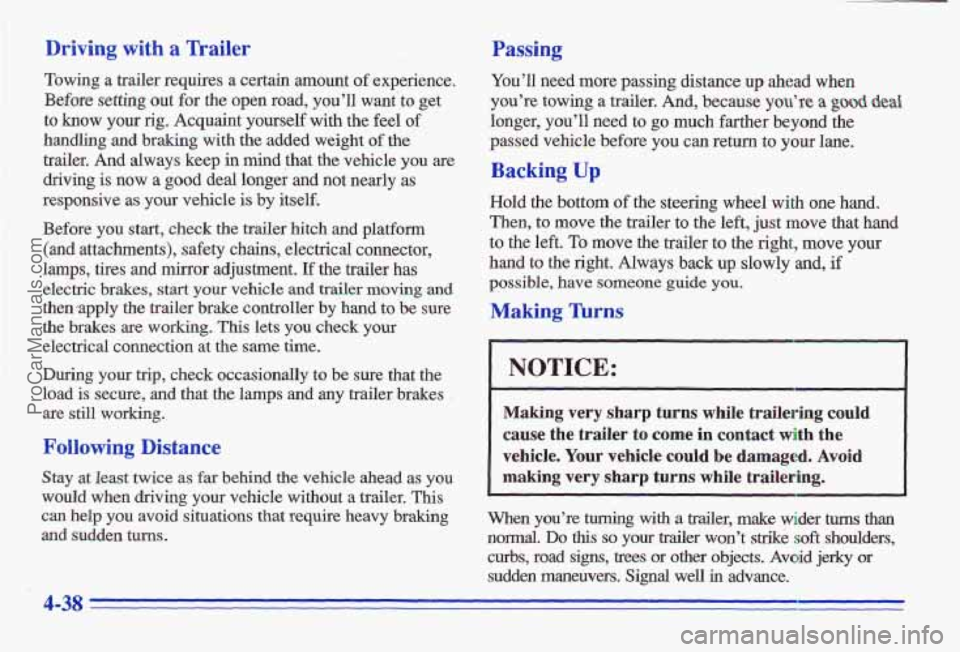
Driving with a Trailer
Towing a trailer requires a certain amount of experience.
Before setting out for the open road, you’ll want’to get
to know your rig. Acquaint yourself with the feel of
handling and braking with the added weight of the
trailer.
And always keep in mind that the vehicle you are
driving is now a good deal longer and not nearly as
responsive as your vehicle is by itselfi.
Before you
start, check the trailer hitch and platform
(and attachments), safety
chains, electrical connector,
lamps, tires and
mirror adjustment, If the trailer has
electric brakes, start your vehicle and trailer moving and
then/apply the trailer brake controller by hand to be sure
the brakes are working. This lets you check your
electrical connection at the
same tirne.
During your trip, check occasionally to be sure that the
load
is secure, and that the lamps and any trailer brakes ,
are still working.
Following Distance
Stay at least twice as far b’ehind the vehicle ahead as you
would when driving your vehicle without a trailer,
This
can help you avoid situations that require heavv braking
and sudden
turns.
Passing
You’ll need more passing distance up ,ahead when
you’re towing a trailer. And, because
you’re a good
longer, you’ll need to go much farther beyond the
passed vehicle before you can return to your lane.
Backing Up
Hold the bottom of the steering wheel with one hand.
Then, to move the trailer to the left, just move that
hand
to the left. To move the trailer to the right, move your
hand to the right. Always back up slowly and, if
possible, have someone guide you.
Making Thrns
I NOTICE:
Making very sharp turns while trailering could
cause th’e trailer to come in contact with the
vehicle. Your vehicle could be damaged. Avoid
making very sharp turns while trailering.
~ ~~ ~~ ~~~
When you’re turning with a trailer, make wider hms than
normal. Do this so your trailer won’t strike soft shoulders,
curbs, road signs, trees or
other objects. Avoid jerky or
sudden maneuvers.
Siggd well in advance.
4-38
ProCarManuals.com